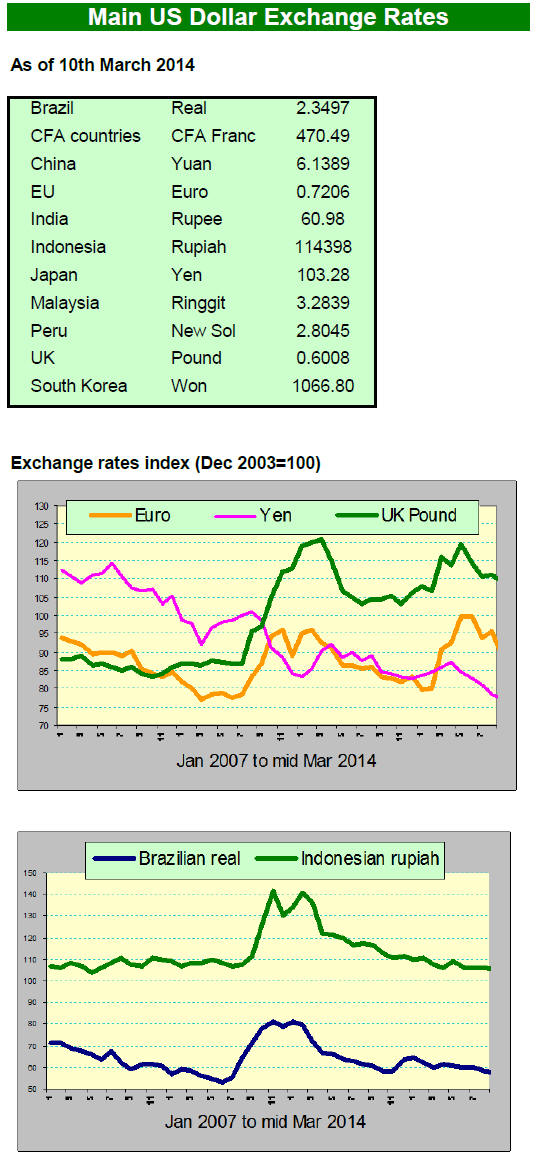2. GHANA
Fuel prices reviewed upwards
Fuel prices were adjusted upwards in the first half of
March and petrol prices have been raised by 2-6%. The
increase in fuel costs is the result of the depreciation of the
cedi and the higher price of crude oil on the world market.
Luckily for the public, the current fuel price increases
have not yet translated into increases in transport fares
however, analysts point out that the price increase on
petrol and diesel will have an effect on timber companies.
VAT on financial services to generate much need
resources
A Value Added Tax (VAT) on financial services in
Ghana, will take effect as soon as on-going talks with the
banking community to identify the chargeable products
and reconfigure their systems are concluded, George
Blankson, Commissioner-General of the Ghana Revenue
Authority (GRA), has said.
The Finance Ministry expects this to boost VAT revenues
by GHS745 million this year and it has promised to spend
the extra money exclusively on infrastructure.
Cedi stabilises after BoG directive
Following directives on foreign exchange transactions
from the Bank of Ghana (BoG) the value of the Ghana
cedi is beginning to stabilise.
Before the BoG measures, the average exchange rate was
GHc 2.40 to the US dollar up from the GHc 2.23 to the
dollar in Jan.2014. The cedi depreciated 7.7% in the
month of January.
VPA conference hosted by GFC in London
The latest FLEGT newsletter has reported that ※Business
operators and NGOs from Europe attended a conference in
London in February to be briefed on Ghana's progress in
preparing for the VPA.
Officials from the Ghana Forestry Commission (GFC)
made presentations on the country‟s experiences and
lessons learnt from implementation of the VPA.
Participants also discussed challenges for small-scale
forest enterprises in meeting legality requirements and the
readiness of Ghana‟s timber industry to obtain FLEGT
licences. Another presentation updated participants on
Ghana‟s progress in developing its electronic timbertracking
system.
In their presentations, Raphael Yeboah and Chris Beeko of
the GFC reiterated the value of the VPA as a powerful tool
for strengthening domestic forest governance.
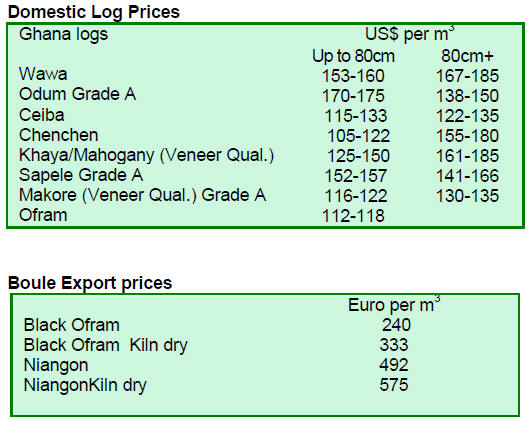
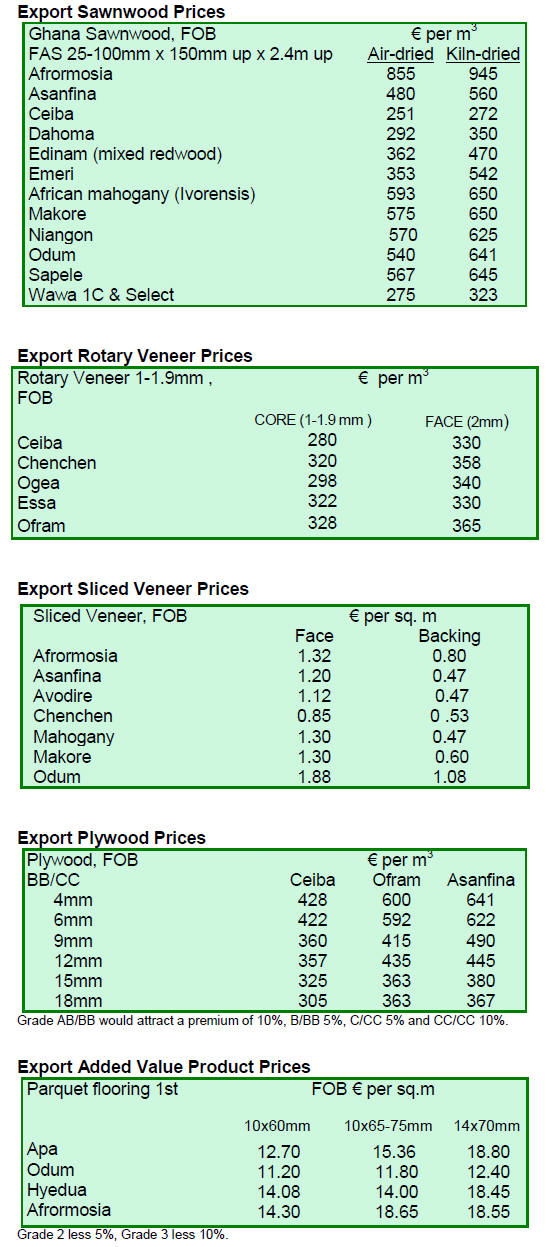
3. MALAYSIA
2013 furniture exports top US$2.2 billion
Furniture is very much in the news this month in Malaysia
as two annual furniture fairs were held in Kuala Lumpur.
The Malaysian furniture industry has come a long way
since its early days when it developed its trade in
rubberwood products.
International demand for Malaysian furniture is strong and
2013 exports were worth RM7.4 billion (approx. US$2.2
billion), the US, Japan, Australia, Singapore and UK were
the top buyers in 2013. Malaysia is the eighth ranked
global furniture exporter.
In recent years Malaysian exporters have been facing
growing competition from Chinese furniture exporters as
well as exporters in Vietnam where, in 2013, furniture
exports were worth US$4.5 billion.
The Malaysian International Furniture Fair (MIFF) was
held over five days and featured over 500 manufacturers
from 13 countries including China, Hong Kong, India,
Indonesia, Singapore, South Korea, Spain, Taiwan, United
Kingdom, the United States, Vietnam, Iran and the host
country.
Sales during the five days of MIFF 2013 have been
estimated at RM2.8 billion (approx. US$854 million), up
by about 5% on last year.
One of the highlights of the latest MIFF were the industry
seminars with topics such as „shaping of Malaysian
designs for the global market‟, „Intellectual property for
the furniture industry‟, and „Award-winning US-patented
high temperature drying technology for rubberwood‟, a
technology developed by the Forest Research Institute
Malaysia.
※MIFF provides a strategic platform for furniture
businesses, contract buyers, international chain stores,
hoteliers, architects and interior decorators to meet and
source for their requirements and establish business
networks,§ said Mohd Ridzal, Deputy Secretary-General
of the Ministry of International Trade and Industry.
An Export Furniture Exhibition (EFE) 2014 was also held
in Kuala Lumpur together with MIFF. The EFE fair had
110 exhibitors displaying a wide range of furniture from
Malaysia as well as overseas. The EFE 2014 is not
exclusively a trade only fair but also caters to consumers
with local visitors making purchases on the spot.
During the 2013 EFE, in-fair sales are said to have totalled
around RM2.2 billion (approx. US$ 680 million). EFE
exhibitors are that a 10 每 20% increase in sales was
achieved during the EFE 2014.
Industry analysts speculate that the furniture industry in
Malaysia will expand to meet growing demand and as
manufacturers in China face increasing production costs,
especially rising wages. Currently, Malaysian production
costs are about the same as those in China but are not
expected to increase significantly in the short term.
Analysts also point out the success of Malaysian producers
in meeting international quality and delivery requirements.
The Malaysian government is making a determined effort
to get manufacturers to move up the value chain and
become „brand manufacturers‟.
Demand changes in Japan and India have strong
impact on export performance
For exporters in Sarawak, India and Japan are the most
important markets for logs and plywood so developments
in these two markets are carefully assessed as they have a
huge impact on export manufacturers.
WTK Holdings Bhd, one of the top producers in Sarawak,
released its financial results for 2013 and these show how
demand in India and Japan drove the group‟s earnings last
year.
In the financial year ending 31 December 2013, WTK‟s
timber division reported a 6.7% growth in pre-tax profit to
RM41.6 million from RM39 million in 2012, this was
despite having sold lower volumes than in the previous
year.
The reduced log lower availability in 2013 pushed up
average selling prices on the back of the firm demand in
the main markets. Average log prices increased by 13.6%
in the final quarter of 2013 year on year while the sales
volume fell 8.7%. In addition to India and Japan the group
exported to Vietnam, Taiwan P.o.C and China.
WTK indicated the average selling price of plywood in the
final quarter jumped by almost 9% while sales volumes
dipped by 5.8% during the same period. Japan was the
group‟s key market, absorbing 88% of its total plywood
exports while Taiwan P.o.C and ASEAN countries
accounted for 10% and 2% respectively.
Log traders in Sarawak report current FOB log export
prices as follows:
meranti SQ US$270 每 290/cu.m
kapur SQ US$340 每 360/cu.m
keruing SQ US$310 每 335/cu.m
selangan batu regular US$515 每 535/cu.m
Plywood traders in Sarawak report current FOB export
prices as follows:
Floor base panels (11.5mm) US$690 每 695/cu.m.
Formboard US$555/cu.m
Middle East (9 每 18mm) US$470/cu.m
Taiwan (8.5 每 17.5mm) US$470 每 480/cu.m
Exports to South Korea (8.5 每 17.5mm) were reportedly at
US$490 每 510/cu.m. C&F.
4. INDONESIA
Indonesia the first to secure VPA
ratification
On 27 February the European parliament ratified the EUIndonesia
Forest Law Enforcement, Governance and
Trade (FLEGT) Voluntary Partnership Agreement (VPA).
This agreement acknowledges that Indonesian timber and
wood products are being certified through the domestic
timber legality verification system (SVLK) as legally
harvested and processed, thus complying with the EU
Timber Regulation, which became effective in March last
year.
With this ratification by the EU, Indonesian timber
producers and exporters have gained a competitive edge in
the EU market said Bayu Krisnamurti, Indonesia‟s
Deputy Trade Minister.
Indonesia is one of the world‟s biggest timber producers
and is set to be the first country to have a VPA ratified by
the European Parliament.
The ratification of the VPA means Indonesian timber and
wood products exported the EU member states are exempt
from the mandatory due diligence requirements applied to
exports from countries which have not yet concluded VPA
negotiations.
Analysts suggest there will likely be a significant jump in
Indonesian wood product exports to the EU and Bayu
Krisnamurthi has said Indonesia expects to increase timber
and wood product shipments to the EU by 5-10 percent
this year.
Indonesia and EU hold first review of VPA
implementation plans
The FLEGT Newsletter has reported that ※representatives
of Indonesia, the EU Delegation to Indonesia and the EU
FLEGT Facility met in Jakarta at the end of January to
assess progress on VPA implementation. Indonesia‟s
representatives included officials from the ministries of
Forestry, Trade and Foreign Affairs and leaders from civil
society and the private sector.
Participants reviewed the joint Indonesia每EU action plan
on VPA implementation, an outcome of the 2013 joint
assessment of Indonesia‟s timber legality assurance
system, SVLK.
Indonesian officials reported progress on the critical issue
and released two new regulations on the SVLK and a third
on imports. Acknowledging the complexity of the
remaining issues in the action plan and the work needed to
maintain stakeholder participation, the two parties
extended the timeframes outlined in the action plan.
Indonesia and the EU also discussed the next joint SVLK
assessment, which they agreed to begin in the second half
of 2014, after the first meeting of the joint implementation
committee.
After the meeting, the Ministry of Forestry organised two
regional multi-stakeholder consultation workshops in
Makassar and Yogyakarta in February on the draft
regulations. A national consultation workshop is planned
for 19 March.§
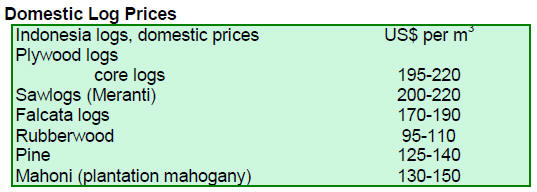
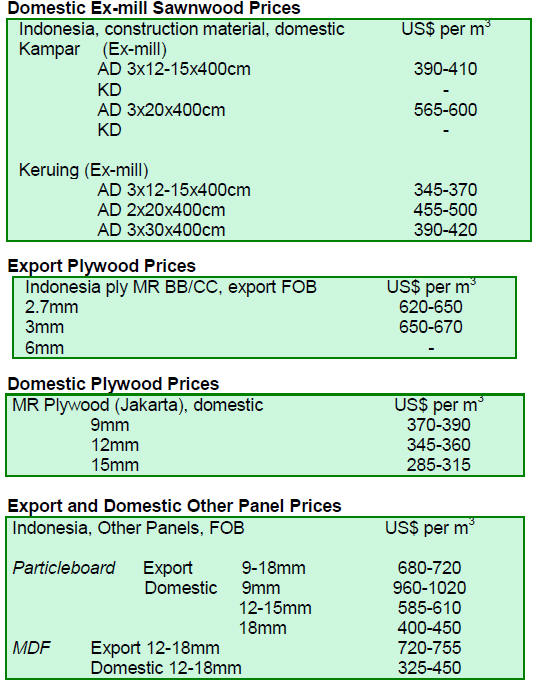
5. MYANMAR
February export shipments the highest in
twelve
months
Log exports from April 2013 to the end of February 2014
are estimated to have been 476,000 cu.m of teak logs and
1,530,070 cu.m of other hardwoods. Some 556,300 cu.m
of teak logs and 1,567,900 cu.m of other hardwoods were
shipped during the 2012-13 financial year.
Teak and other hardwood log shipments in February were
the highest for the year to date at 123,875 cu.m of teak and
222,975 cu.m of other hardwoods. As 31 March is the last
date for log exports both sellers and buyers are anxious to
ship as much as possible before the deadline.
Directive on hewn teak, baulks and boule exports
On 26 February, following a directive from the Ministry of
Environment Conservation and Forestry, the Myanma
Timber Enterprise (MTE) announced that, from 1 April
this year all hewn (half squared or roughly squared handsawn)
teak and hardwoods must be further processed
domestically before export.
Similarly, baulks, and logs cut into boules must also be
further manufactured into processed wood products to
qualify for shipment.
FDI in wood processing tops US$51 mil. - India the
biggest investor
The Irrawaddy News Journal of 5 March has quoted
Directorate of Investment and Company Administration
sources saying that 8 timber processing licenses were
granted to foreign firms in the 2013-14 financial year.
Five companies from India were granted licenses
valued
US$26 million, two companies from Singapore received
licenses valued US$24 million and one Korean company
obtained a license valued at almost US$1 million.
3rd BIMSTEC Summit
The Third Bay of Bengal Initiative for Multi-Sectoral
Technical and Economic Cooperation (BIMSTEC)
summit, with participation from Bangladesh, Bhutan,
India, Myanmar, Nepal, Sri Lanka, and Thailand was held
at Naypyitaw on 4 March.
Member states signed two MOAs and one MOU including
the establishment of a Centre for Weather and Climate. A
Centre for Weather and Climate is to be set up near New
Dehli and India agreed to provide 35% of the budget.
The summit also laid out plans to enhance cooperation in
expanding skill and technology base of member states
through collaboration and partnerships in 14 sectors: trade
and investment, technology, energy, transport and
communications, tourism, fisheries, agriculture, cultural
cooperation, environment and disaster management, public
health, counter terrorism and transnational crime, and
climate change. A BIMSTEC secretariat will be
established in Dhaka, Bangladesh.
Teak open tender prices
The following regular items were sold by competitive
bidding on 7 March 2014 at the Myanma Timber
Enterprise (MTE) tender hall.
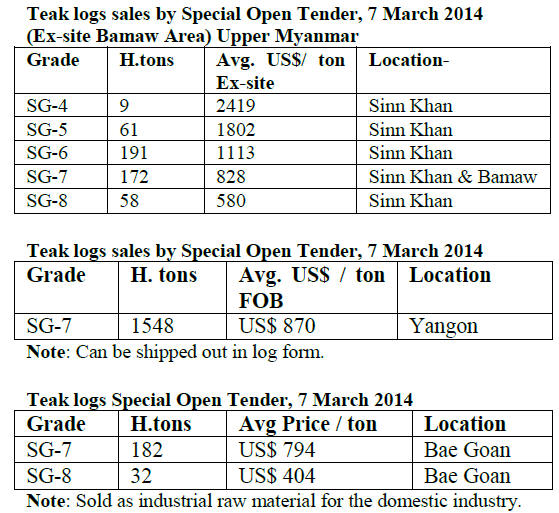
Analysts point out that the SG-7 and SG-8 teak logs
sold
in special open tenders were of lower quality than those
usually sold in the tender sales and because of this prices
were much lower than usual.
6.
INDIA
Wholesale price index down
The Office of the Economic Adviser to the Indian
government provides details of trend in the Wholesale
Price Index (WPI). The official Wholesale Price Index for
„All Commodities‟ (Base: 2004-05 = 100) for the month of
January 2014 declined to 178.9 from 179.2 in December
2013.
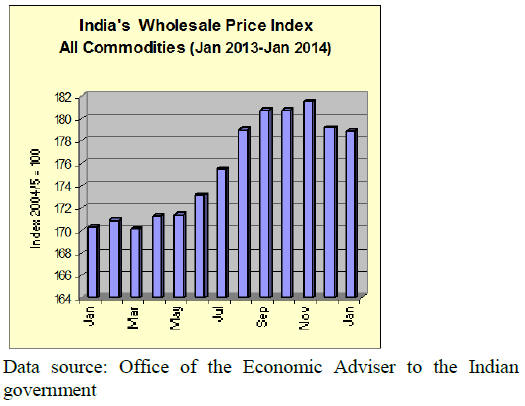
It has been estimated that February inflation was
up by
around 8 percent year on year, this compares to the almost
9% increase from December 2013 to January 2014.
Slightly lower food prices are suggested as one of the
main reasons for the decline in inflation. The decline
seems less to do with the actions of the Reserve Bank in
raising interest rates than changes in seasonal agricultural
output.
Weak February export data undermines optimism
Improved domestic consumption and increased exports
have been providing support to the economy and India‟s
PMI, for the manufacturing sector moved to a twelve
month high of 52.5 in February. The consumer goods
segment was again the best performing sub-sector, leading
to a rise in both output and new orders. However capital
investment remains stalled.
Export orders in the final quarter of 2013 rose 7.5%
compared to the previous quarter topping US$78.9 billion
and this generated optimism, boosted manufacturing
output and created more employment opportunities.
The last quarter 2103 export performance, coupled with
the slowing of gold imports, lowered India‟s current
account deficit to a four year low of US$4.2 billion or
0.9% of GDP at the end of 2013.
However, data from the ministry of trade has revealed that
exports fell in February, the first decline in eight months.
If this downward trend continues then expectations for an
export led recovery would fade.
The statistics show that February exports fell 3.7%
from a
year earlier to around US$26 billion and analysts blame
weakening demand in the US and EU.
Timber and plywood wholesale price indices
In addition to data on the Wholesale Price Index for all
commodities, the Office of the Economic Adviser to the
Indian government also reports data on wholesale price
movements for a variety of wood products.
The Wholesale Price Indices for Logs/timber and plywood
are shown below. The logs/timber index continues to show
considerable volatility.
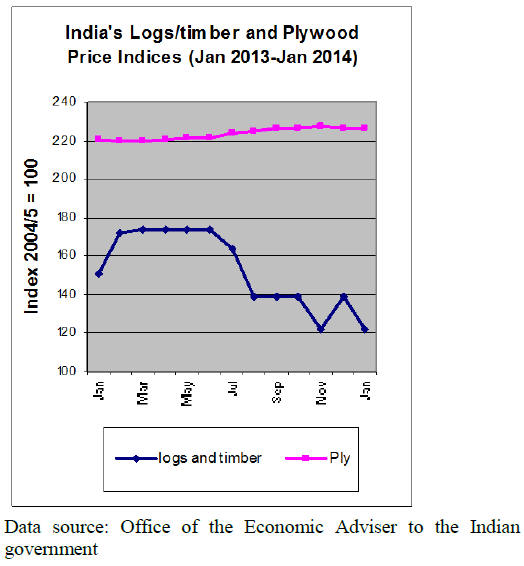
Rs 30 billion project to increase forest cover
The government of India has finally approved as a
"centrally sponsored scheme" a much awaited 'Green India
Mission' proposal of the Ministry of Environment and
Forests to increase forest cover in the country.
An official press release says: "Of the total expenditure of
Rs130 billion envisaged, the initial phase will require
some Rs 20 billion and that funding will come from the
Mahatma Gandhi National Rural Employment Guarantee
Act, the Compensatory Afforestation Fund Management
and Planning and the National Authority for Plantations ".
The objectives of the programme include increasing
forest/tree include improving the quality of this forest
cover, improving the ecosystem services including
biodiversity, hydrological services and increasing
opportunities for forest-based livelihood income
generation by households and sequestration of carbon.
A multidisciplinary team, from the government and NGOs
will be mandated to facilitate planning and implementation
at cluster/landscape unit level", said the official release.
Sweet smell of sandalwood prices drives interest
in
planting
The ever increasing prices for sandalwood and its oil is
stimulating investment in plantations by the government
and the private sectors.
Analysts point out that legislative amendments are
urgently required to allow private individuals and farmers
to take up sandalwood cultivation. Suitable growing
conditions exist in the four southern states and elsewhere
in the country and efforts are required to increase the area
under plantations.
Experts have pointed out that as against 3,000 tons of this
wood was produced annually in 1960s and 70s, but this
has now fallen to a mere 400 tons. Similarly sandalwood
oil production has also declined from 150 tons in 1970s to
just about 20 tons currently, necessitating imports of the
oil to meet the needs of local industries.
Currently the prices for sandalwood is around
US$1,25,000 per ton of wood and oil prices are about
US$2,200 per kg.
Plantation teak import prices
India‟s total imports of wood and wood products under HS
chapter 44 for the month of February 2014 were
US$207.51 million and exports under the same chapter
were US$23,04 million. Domestic demand continues to
be firm.
Current C & F prices for imported plantation teak, Indian
ports per cubic metre are shown below.

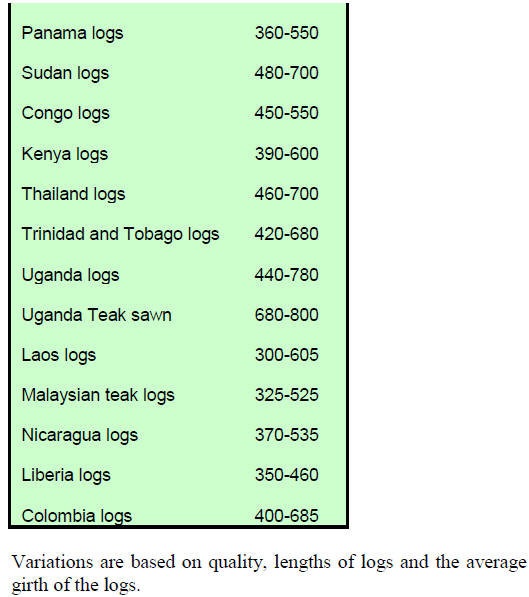
Prices for domestically sawn imported logs
Prices for air dry sawnwood per cubic Foot, ex-sawmill
are shown below.
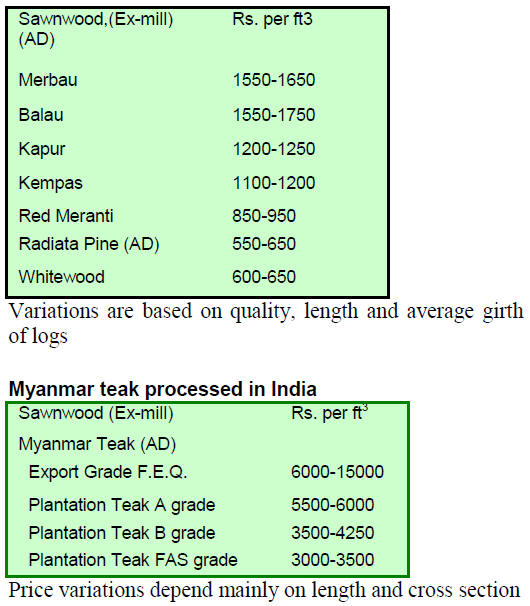
Imported sawnwood prices
Ex-warehouse prices for imported kiln dry (12% mc.)
sawnwood per cu.ft are shown below.
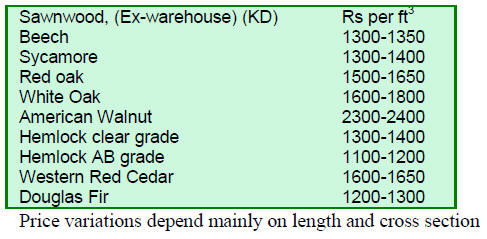
Plywood market slow to revive
Domestic manufacturers continue to report slow market
conditions and put this down to the subdued housing
sector. Prices remain unchanged.
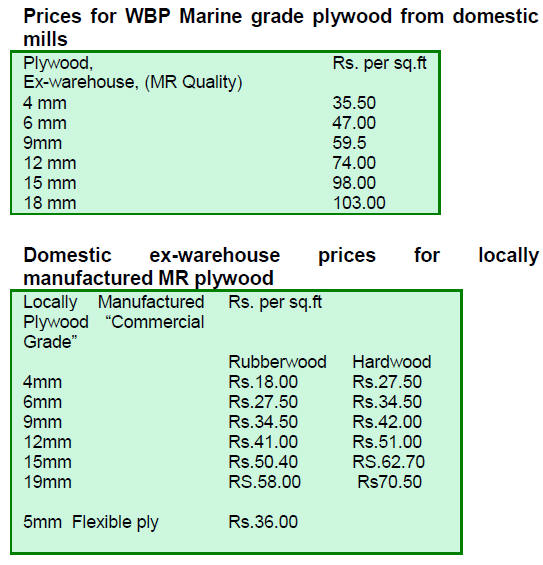
7.
BRAZIL
Recovery of Brazilian pine plywood
exports
In 2013, there was a 24% increase in pine plywood
exports, the first increase in five years. The main markets
were Europe (71%) and North America (13%). Before the
2008/9 financial crisis the US was the main international
market for pine plywood.
According to the Brazilian Association of Mechanically
Processed Timber Industry (ABIMCI), the increase in
exports is the result of promotional efforts by the pine
plywood industry and the recent favorable exchange rate
which also helped the recovery.
However, ABIMCI warns it is necessary to continue with
the promotional efforts to secure better prices in
international markets.
In 2013, Brazilian pine plywood exports were 1.164
million cubic metres but in 2007, before the financial
crisis Brazil exported 1.536 million cubic metres.
Paran芍 state is the main pine plywood producer but
exports transaction costs are high because of taxes and
container handling fees at the Port of Paranagu芍. These
problems are compounded by the higher than average
minimum wage paid by companies in the state.
Earnings in the furniture industry drop
Despite an overall improvement in output and revenue in
the timber sector in 2013 the Brazilian wooden furniture
manufacturing sub-sector did not perform as well. In 2103
output from the furniture sector rose slightly but sector
revenues fell by approximately 2.5%.
According to the Brazilian Institute of Geography and
Statistics (IBGE) in 2013 furniture production increased
2.1% compared to 2012 but production by the whole
timber sector rose 4.6%,
The National Confederation of Industry has reported that
the utilisation of installed capacity in the furniture sector
increased 0.7% while that for the whole timber sector
increased by 2.3%.
Overall, the Brazilian wood processing industry achieved
a 3.8% growth in 2013, partially recovering the losses of
2012. Analysts say continued growth into 2014 could be
affected by a strengthening of the Brazilian currency and a
reigning in of credit as the central bank introduces further
monetary tightening.
Mato Grosso is the largest teak producer in Brazil
According to the Brazilian Association of Planted Forest
Producers (ABRAFLOR) the state of Mato Grosso is the
largest plantation teak producer in Brazil, with some
65,000 hectares of plantations. However, teak plantations
represent only 4% of the 5.1 mil. ha. of plantations in
Brazil, the majority being eucalyptus.
The Federation of Agriculture and Livestock in Mato
Grosso (FAMATO) has said the state has an opportunity
to expand the area of plantations but the lack of skilled
labour is a major constraint.
Teak is suited to the environmental conditions in Mato
Grosso but forestry companies in the state claim that, even
though there is a strong demand for teak in international
markets, the poor infrastructure in the state is holding back
development of the plantation sector.
São Paulo Furniture and Decoration Fair a success
The 17th Furniture and Decoration Accessories Fair, the
leading furniture and decoration accessories trade fair in
Latin America, was held in mid-February in São Paulo and
exceeded expectations.
The fair attracted 22,400 visitors including retailers and
professionals in the furniture and interior design industry
as well as importers from countries such as Bolivia, Chile,
Colombia, Dominican Republic, Ecuador, Guatemala,
Mexico, Panama, Paraguay, Peru, Puerto Rico, Uruguay
and Venezuela.
The fair generated business worth around R$200 mil. and
post-fair sales have been estimated at around R$300 mil.
The 18th Furniture and Decoration Accessories Fair will
take place in August, this year and will be held again in
São Paulo.
Price trends
Brazilian prices remain unchanged.
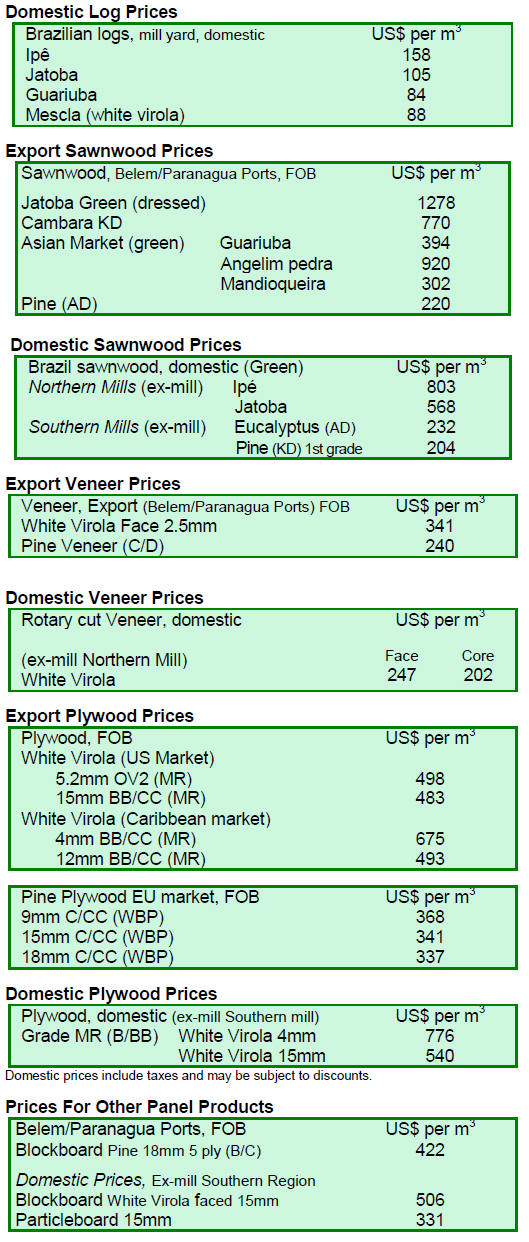

8. PERU
Disappointing export data from ADEX
According to statistics from the Exporters Association of
Peru (ADEX), 2013 exports of wood products were valued
at US$159.7 million FOB in contrast to the US$166.27
million in 2012, a decline of 3.9%.
In 2013 the three main markets for wood products from
Peru were China, United States and Mexico. Together
these three countries accounted for 74% of all wood
product exports.
The main items exported to China were strips and friezes
for flooring while the US market took mostly builders
woodwork and carpentry as well as blockboard. Demand
from China expanded 5% in 2013 while demand in the US
increased by 11%. In contrast, Mexican imports in 2013
fell 24%.
During 2013 exports of sawnwood were the second most
important category of exports accounting for around 36%
of all exports in value terms. 2013 exports of sawnwood
totalled US57.2 million FOB compared to the US66.4
million in 2012; a decline of almost 14%. The main
market for Peru‟s sawnwood in 2013 was China.
Exports of semi-manufactured products in 2013 were
valued at US$59.4 million FOB, up around 4% on levels
in 2012. China was the main buyer of semi-manufactured
products from Peru and accounted for 61% of all exports
of this category of product.
Encouragingly, demand for Peru‟s semi-manufactured
products from the US and Sweden expanded in 2013.
Exports of plywood and veneered panels in 2013 were
worth US$17.9 million FOB and Mexico was the main
market. However, 2013 exports of plywood and veneered
panels were down 19% compared to 2012.
Peru‟s 2013 exports of furniture and parts were valued at
US$7.9 million FOB, up 4.5% on 2012. The US market
accounted for over 60% of exports of furniture and parts
followed by Italy (13.5%).
Finland and IICA presented results forestry
innovations forum
At a Regional Forum in Lima from 5 to 7 March, progress
on the first phase some 24 projects promoting Sustainable
Forest Management Programe in the Andean Region was
assessed.
The Forum focused on highlighting innovations and
lessons learned from each of the four participating
countries Bolivia, Colombia, Ecuador and Peru. The
Forum provided the opportunity to validate innovations
and prepare strategies for replication and scaling of these
innovations such that they will be translated into expanded
investment and government policies.
A set of innovations, best practices and guidelines for
replication and scaling have been analyzed under the
umbrella of four themes related to sustainable forest
management in the region : the formation of multistakeholder
partnerships, compensation schemes for
environmental services, forest management Community
and diversification and value addition of forest products.
For more see:
http://forestalsostenibleandina.net/Noticias/noticiasforestales/
Finlandia-e-IICA-presentaron-innovacionesforestal.
aspx

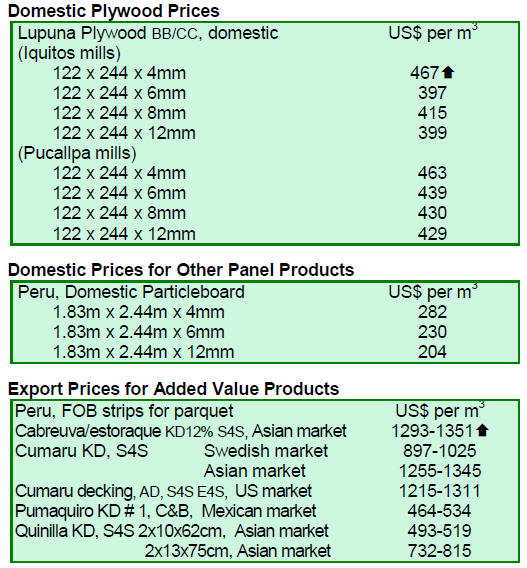
9.
GUYANA
Mora log prices ease
In the period reviewed there were no exports of greenheart
logs. Purpleheart logs were exported however, but FOB
prices eased slightly.
For Standard sawmill quality purpleheart logs the top end
price fell from US$385 to US$235 per cubic metre FOB.
Similarly, there was a decline in price of Fair sawmill
quality purpleheart logs from US$300 to US$200 per
cubic metre FOB. However, for Small sawmill quality
purpleheart logs prices held firm at US$150 per cubic
metre FOB.
Mora log prices have also eased in recent weeks. Standard
sawmill quality mora FOB prices dipped from US$160 to
US$120 per cubic metre. Similarly for Fair sawmill
quality the price fell from US$140 to US$115 per cubic
metre FOB. Other logs, especially the lesser used but
commercial, species were exported.
Sawnwood prices remain firm
Despite the easing of log prices, sawnwood prices
remained firm. Undressed greenheart (Prime quality) saw
a significant increase in FOB prices from US$1,058 to
US$1,657 per cubic metre.
However, Select quality greenheart sawn prices fell from a
top end price of US$1,060 to US$848 per cubic metre
FOB. Sound quality greenheart sawnwood FOB prices
were fair at US$784 per cubic metre.
Undressed purpleheart sawnwood prices were largely
steady but Select quality sawnwood recorded a slight
increase in its top end price from US$1,000 to US$1,080
per cubic metre.
On the other hand, Undressed mora (Select quality) prices
surged from US$785 to US$976 per cubic metre FOB but
Merchantable quality mora sawnwood prices held firm at
US$500 per cubic metre FOB.
The main markets for sawn greenheart, purpleheart and
mora were the Caribbean, Europe, Middle East Oceanic
Region and North America.
Competition drives down dressed sawnwood prices
In contrast to the price movements of rough sawn timbers,
export prices for dressed sawnwood fell in the period
reviewed.
Dressed greenheart export prices fell from US$1,272 to
US$1,060 per cubic metre while Dressed purpleheart FOB
prices slipped from US$1,160 to US$869 per cubic metre.
The Caribbean and the Middle East market of U.A.E
absorbed most of these products.
Many of Guyana‟s lesser known species made their way
onto the international market at prices which were
attractive for producers. Guyana‟s washiba (ipe) continued
to rank high in terms of export market prices earning as
much as US$2,450 per cubic metre FOB in the US market.
Plywood prices remained firm at US$584 per cubic metre
FOB in the Caribbean and South American markets.
Greenheart pile prices were favourable. Select quality
piling earned as much as US$718 per cubic metre FOB
and Sound quality piling attracted prices as high as
US$388 per cubic metre. Europe and North America were
the top buyers of this durable timber product from
Guyana.
Similarly, wallaba poles of Select quality also attracted
favourable market prices as much as US$824 per cubic
metre FOB with the Caribbean being the foundation of this
market. During this period Splitwood (shingles)
maintained a strong presence in the Caribbean, Central
American and North American markets earning as much
as US$1,091 per cubic metre FOB.
Guyana‟s value added products made their way onto
export markets in the form of doors, indoor furniture,
crafts and wooden ornaments and utensils.
Increased demand in the domestic utilities sector
Guyana is currently experiencing a building boom and
this has resulted in increased domestic consumption of
sawnwood, plywood, joinery as well as poles and posts.
Recently, the Guyana Power and Light Inc. has been
expanding its electrification programme in areas not
served by the existing power grid such as in the new
housing schemes being established across Guyana. This
expansion of the power grid has created an extra demand
for transmission poles.
In addition, many large buildings are being
constructed
and this has led to increased demand for piles for
foundations purposes.
Wallaba is recognised both locally and internationally as a
leading highly durable tropical timber suitable for
transmission poles. Similarly Greenheart is also known
internationally as a leading species for construction piling.
Apart from the commonly know timbers there are many
species that can substitute for the establish species. For
instance suya (Pouteria speciosa) can be used for poles and
posts while black kakaralli (Eschweilera sagotiana) can be
utilised for piles. These timbers however, require some
form of preservative treatment.
The Forest Products Development and Marketing Council
of the Guyana forestry Commission, in an effort to educate
consumers on a wider range of timbers has embarked on a
campaign to publicise consumers of the characteristics and
properties of these lesser used species.
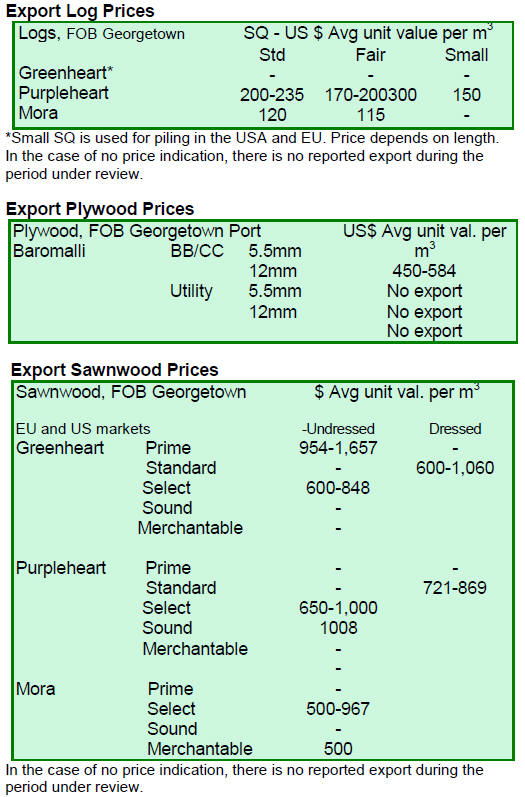
﹛
